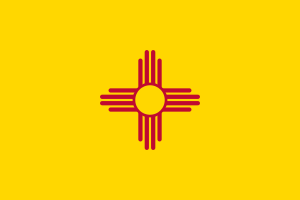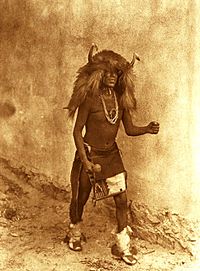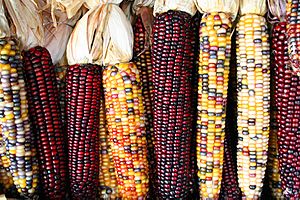Zia people (New Mexico) facts for kids
| Sia [Zia] buffalo dancer, c. 1925, Edward S. Curtis photo | |
| Total population | |
|---|---|
| 850 | |
| Regions with significant populations | |
( |
|
| Languages | |
| Keresan, English, Spanish | |
| Related ethnic groups | |
| Pueblo community | |
|
PUEBLO OF ZIA 2009 GOVERNOR IVAN R. PINO |
The Zia people, also known as Tsʾíiyʾamʾé, are an indigenous nation in the United States. They live at Zia Pueblo (Tsi'ya), which is a Native American reservation in New Mexico. The Zia are famous for their beautiful pottery and their special sun symbol. They are part of the Keres Pueblo peoples and speak the Eastern Keres language.
Contents
History of the Zia People
Archaeologists believe the Zia people are descendants of the Ancestral Puebloans. These ancient people lived in the Four Corners area. They moved to the Jemez River Valley around the 1200s.
First Contact with Europeans
The Spanish explorer Antonio de Espejo first met the Zia in 1583. He wrote that their biggest village was called Tsiya. The Spanish later changed this name to Zia.
Spanish settlers and religious groups slowly took control of the area. They made it illegal for the Zia to practice their traditional religious ceremonies. The first missionary came to the Zia in 1598. By 1613, the Zia people had built a church and a convent for the Spanish.
The Pueblo Revolt
Tensions grew between the Spanish and the Zia. In 1680, a big uprising happened across the region. It was led by Popé, a Tewa religious leader. This uprising, called the Pueblo Revolt, successfully pushed the Spanish out. The Spanish were forced to leave and go south. The Pueblo Indians also got horses from the Spanish. This helped horses spread to the Plains tribes.
The Spanish did not return for nine years. In 1689, soldiers led by Governor Domingo Jironza Petriz de Cruzate attacked Zia Pueblo. They killed 600 people and captured 70 Zia Indians. Three years later, the Spanish had stopped all Pueblo resistance. They convinced the Zia people and their leader, Antonio Malacate, to return home. However, fighting and disease had greatly reduced their numbers. By 1892, only about 120 people lived in Zia.
Daily Life and Culture
How Did Zia People Farm?
The Zia live in a very dry (arid) desert climate. They had to find smart ways to live in this land. Since they lived in permanent homes and were not nomads, farming was very important for their food.
Rain was rare in New Mexico during certain times of the year. So, the Zia developed new farming methods. These included dry farming and crop rotation. They would plant seeds in good soil near a river or stream. Then, they dug paths from the stream to their fields. Water flowed through these paths to water the crops. They also used rocks in the paths to control the water flow.
In higher areas, men planted seeds on sunny slopes. When it rained, the water ran down the slope to water the crops. Another method was digging trenches. These trenches acted like cisterns to collect rainwater. Women would use clay pots to carry water from these trenches to the fields.
What Crops Did They Grow?
Zia farmers grew many different crops. The most important were corn, beans, and squash. These three crops were so important they were called the "three sisters." They were planted in shared fields where everyone helped. These crops were the main food for the Zia and other Pueblo people.
Corn was the most important crop. Some corn was eaten fresh. Most was stored in pots and cellars for winter or dry times. When some corn dried, women ground it into flour and made bread. They sat outside at grinding stones, singing religious songs. They sang because they believed corn was sacred.
Once the flour was ready, it was mixed with water to make dough. The dough was flattened into round, thin sheets. These were placed on hot rocks over a fire. This made a tortilla, which was a very important food.
Other smaller crops were grown in personal gardens. These included peppers, onions, chiles, and tobacco. New Mexico is famous for its spicy chiles, which came from tribes like the Zia.
What Did They Eat for Meat?
The Zia people mainly ate vegetables. However, they ate meat when they could get it. Small groups of men and teenage boys went hunting. They hunted small animals like rabbits, gophers, and squirrels. They also hunted larger animals such as deer, antelope, and mountain lions. In the spring, special groups would go near the Great Plains to hunt bison.
How Did Zia People Build Their Homes?
The native people of the southwestern United States, including the Zia, built "pueblo homes" from adobe. These homes looked like apartment buildings. They had a large base, with smaller boxes built on top. This created different floors for storing things and for families.
Until recently, the ground floor had no doors. The only way to get into the building was by using ladders made from logs. One ladder went from the ground to the second-floor patio. Another ladder went through an opening in the roof and down to the first floor. Other ladders led to higher floors. At night, ladders were pulled inside for safety. This stopped outsiders from entering without permission.
Adobe houses are made from natural materials found in the desert. Adobe is a building block made by mixing clay, sand, water, and natural materials like sticks, straw, and animal dung. This mixture is formed into blocks and left to dry. Then, a hole is dug for the new building. Strong poles are placed in the ground to create a frame. Once the adobe blocks are dry and hard, they are laid around the frame. Wet clay is used like cement to hold them together. Every year, a new layer of adobe mixture or clay is added to the walls to keep them strong.
Religious Customs
What are Kachinas?
The Zia, like other Pueblo peoples, believe in spirits called kachinas. These are thought to be the spirits of ancestors who once lived among their people. The spirits were believed to get upset if people did not pay attention to them. So, they went to live in the sky. It was said they would visit sometimes to bring rain and clouds.
There are over 300 kachinas in their worship. The Zia held religious festivals and ceremonies to ask the kachinas for rain and good crops. They used drums and rattles during the dances in these ceremonies. Religious men dressed as kachinas would come down from the mountains. They danced among the people during the festival. After three days, they would go back up.
Art of the Zia People
Zia Pottery
Pottery is a very well-known art form and an important part of daily life in Zia Pueblo. Zia pottery is known for its high quality. Because the land around the pueblo was not good for farming, pottery was historically important for trading with other groups. By the late 1800s, only about 25 women or fewer were making all the pottery for the village.
Zia pottery is special because it is made with basalt. Basalt is a hard volcanic rock. Potters mix clay and ground basalt with water. Then, they coil ropes of this mixture into specific shapes. Once the pots dry, they are painted with nature and religious symbols. They sit for about a week before being fired in a kiln. Cattle dung is often used as fuel for the kiln. Common designs include geometric shapes, plants, and animals. These designs are often on a white or red background.
Most pottery is made by women. One of the most famous Zia potters is Elizabeth Toya Medina (who was originally from Jemez).
The Sacred Sun Symbol

The Zia people consider the Sun to be sacred. Their solar symbol is a red circle with groups of rays pointing in four directions. This symbol is painted on special ceremonial vases. It is also drawn on the ground around campfires. New babies are introduced to the Sun using this symbol.
The number four is sacred to the Zia. You can see it repeated in the four points that come out from the circle. The number four is important in many ways:
- The four points of the compass: north, south, east, and west.
- The four seasons of the year: spring, summer, autumn, and winter.
- The four parts of each day: morning, noon, evening, and night.
- The four stages of life: childhood, youth, middle years, and old age.
- The four sacred duties a person must develop: a strong body, a clear mind, a pure spirit, and caring for others.
This symbol represents the wider Puebloan and Hispano cultures in New Mexico. For example, it is on the flag of New Mexico. It is also in the design of the New Mexico State Capitol. You can see it on New Mexico's State Quarter coin. Many city flags, like those of Albuquerque and Roswell, also use it. It is even on the state highway markers.
The Zia tribe does not own a trademark for the symbol. This is because, under U.S. federal law, it is used everywhere in the region. The state government of New Mexico helps people learn about how to use the sun symbol respectfully. They provide information from Zia Pueblo and the Indian Pueblo Cultural Center in Albuquerque. This includes how to get permission for commercial use. The symbol was on the flag of Madison, Wisconsin from 1962 to 2018. It was removed because of concerns about using the Zia, Puebloan, and New Mexican symbol without proper respect.
Famous Zia People
- Marcelina Herrera, a painter
- Elizabeth Toya Medina, a potter (originally from Jemez)
Images for kids
-
Sia [Zia] buffalo dancer, c. 1925, Edward S. Curtis photo
-
The Zia sun Symbol is featured on the New Mexico flag.
See also
 In Spanish: Zía para niños
In Spanish: Zía para niños








